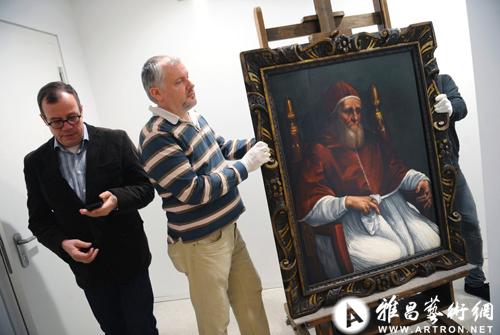编制机构:雅昌艺术市场监测中心(AMMA)

Employees of the Staedel Museum transport the portrait of Pope Julius II by Raphael to its display location in Frankfurt Main,Germany, 06 December 2011. Stephan Knobloch (L), director of the restoration workshop at the Staedel accompanies them. According to museum director Hollein, the museum is extraordinarily happy to have this high Rennaissance work in their collection of old masters. There are a few versions of the painting in existance; one hangs in London, one in Florence. EPA/ANDREAS ARNOLD.
The portrait of Pope Julius II is one of Raphael’s most famous works. It was in Rome between June 1511 and March 1512 that the artist executed his likeness of this highly art-minded – but also extremely strong-willed and irascible – pope. It shows the bearded pope in a three-quarter view, life-size, sitting in an armchair. The portrait has come down to us in several versions, of which the most well-known is in the holdings of the National Gallery in London, and another is in those of the Uffizi in Florence. The Städel Museum quite recently succeeded in acquiring a hitherto unknown version of the portrait of Pope Julius II by Raphael and his workshop.
Measuring 106 by 78.4 cm and painted on a poplar panel, the work has been comprehensively examined and analyzed by art-historical as well as technological methods, and old retouchings and layers of varnish have been removed. The likeness is captivating not only by virtue of its artistic quality, but – unlike the versions in London and Florence – exhibits a series of creative changes carried out in the course of its execution. The underlying drawing made visible with the aid of infrared reflectography reveals that revisions were made above all in the area of the face and the position of the chair. As is documented by the x-ray image, the pose of the right hand was also altered during the painting process. These interventions and the special character of the underdrawings testify to an exceedingly creative approach to pictorial invention which lends this work a special status in comparison to the better-known portraits of Julius.
The painting’s provenance can be traced without interruption back to 1905, when it was auctioned off at the Hôtel Drouot in Paris as part of the Bercioux collection. Via various private owners, it then made its way from Paris to New York by 1909, and returned to Europe in 1914. In 2007, following further changes of ownership, it was offered at the Dorotheum in Vienna as a work by an imitator of Raphael. There it was purchased by the private Ellermann collection, from which the Städel had the fortune of purchasing it at a price substantially below market value thanks to the good will of the seller. The conjectured provenance of the painting before this thread is taken up in 1905 leads back to the family of Julius II himself.
Precisely that pre-1905 provenance – and above all the work’s comparison with the well-known versions of the portrait in London and Florence – will be the subject of an exhibition entitled “Raphael and the Portrait of Julius II: Pictorial Propaganda of a Renaissance Pope”, to take place at the Städel from November 2012 to February 2013.
Starting on 15 December 2011, following a fourteen-month period in which the museum was closed for refurbishment, the painting of Julius II will be placed on view at the Städel for the first time within the framework of the re-opened and newly designed presentation of the “Old Masters” collection.
“We consider ourselves extraordinarily fortunate”, says Max Hollein, Städel Museum director, “to have secured such a superb High Renaissance work for our Old Masters’ collection. For a museum with a nearly two-hundred-year-old tradition of research on Raphael and a collection of prints and drawings encompassing important works by this artist, the new acquisition is of very special significance.”
“The Julius portrait further enhances the magnificent series of Renaissance and Mannerist portraits at the Städel. The procurement of a work providing such exciting insights into the creative process carried out by Raphael and his workshop is an exceptional stroke of luck”, comments Prof Dr Jochen Sander, head of the “Old Masters” Department.

网友评论仅供其表达个人看法,并不表明本站同意其观点或证实其描述。